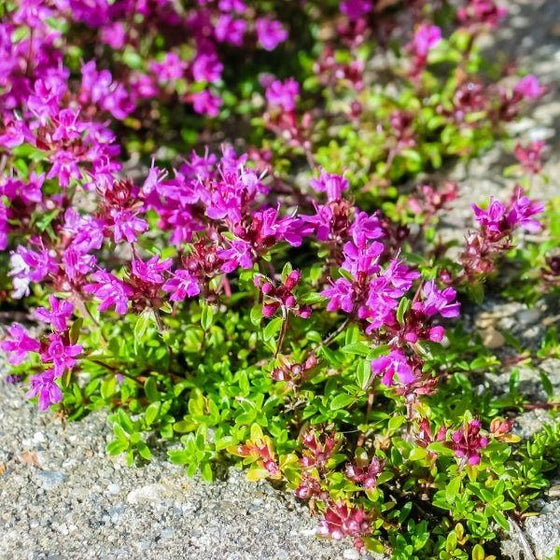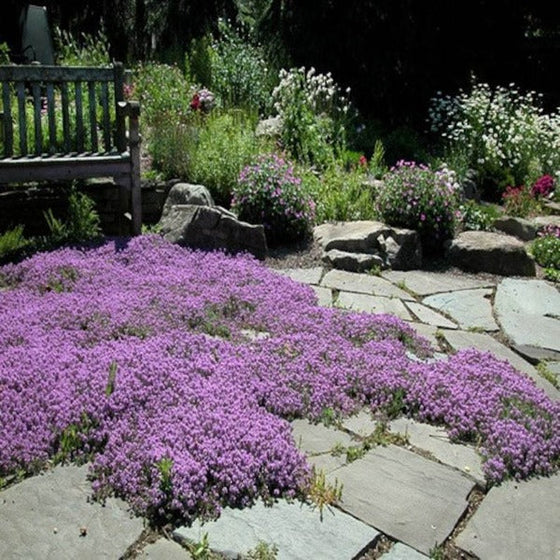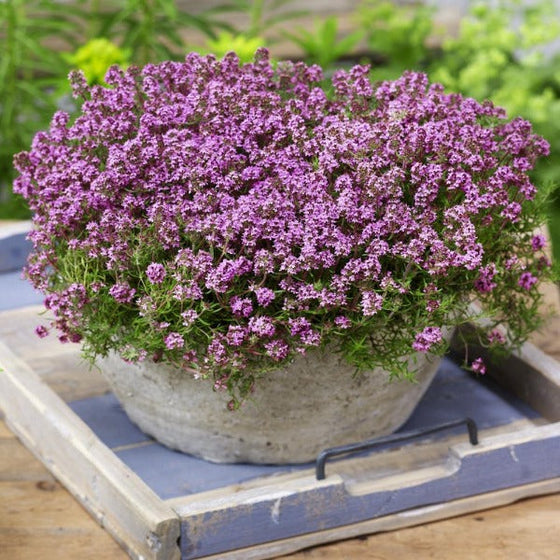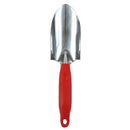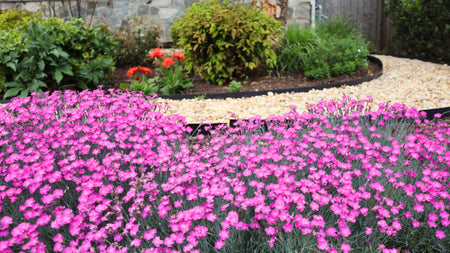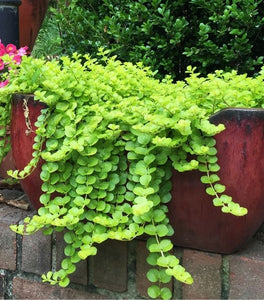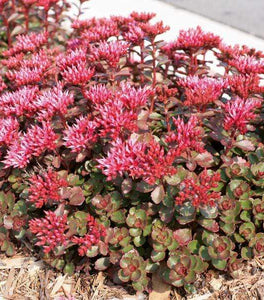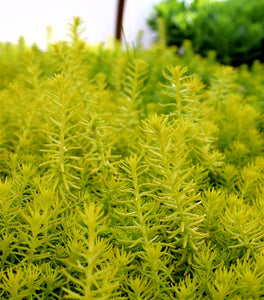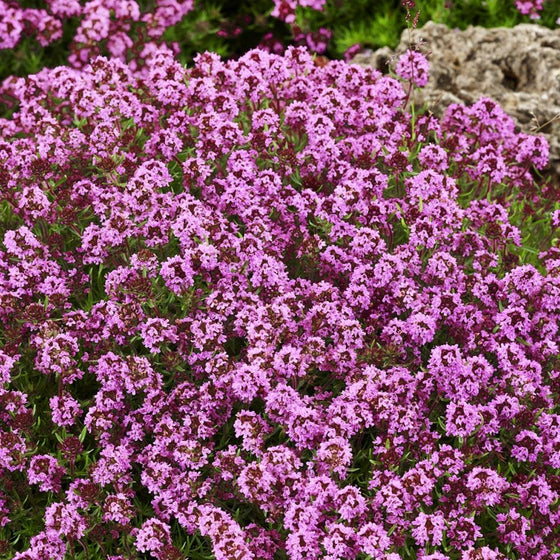
Images Depict Mature Plants
Red Creeping Thyme for Sale Online
Red Creeping Thyme (Thymus praecox ‘Coccineus’) is a low-growing, fragrant perennial herb that offers vibrant groundcover with beautiful magenta-red flowers in late spring to early summer. Growing to a height of only 2-4 inches and spreading up to 12-18 inches wide, this creeping thyme forms a dense, mat-like cover ideal for filling gaps between stepping stones, rock gardens, or sunny borders. When brushed or walked on, the tiny, aromatic leaves release a pleasant herbal scent, making Red Creeping Thyme a delightful addition to any landscape.
Hardy in USDA Zones 4-9, Red Creeping Thyme thrives in full sun and well-drained soil, making it a perfect choice for dry, sunny areas where other plants may struggle. This drought-tolerant groundcover is an excellent option for xeriscaping or erosion control on slopes, as it requires minimal water once established. During the blooming season, the bright red flowers attract pollinators such as bees and butterflies, adding both beauty and ecological value to your garden. Its evergreen nature in milder climates ensures that it provides year-round interest, even when not in bloom.
In addition to its visual appeal, Red Creeping Thyme is a low-maintenance, deer-resistant plant, making it ideal for gardens where wildlife browsing is a concern. It also tolerates light foot traffic, making it an excellent choice for pathways, patios, or as a living mulch. Whether used as a groundcover, in mixed perennial borders, or as a fragrant accent plant, Red Creeping Thyme adds color, texture, and fragrance to your garden while requiring little care.
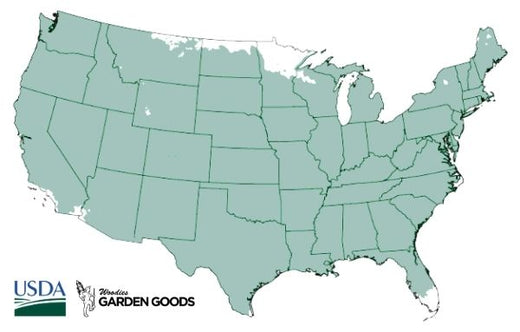
| Hardiness Zone: | 4-9 |
|---|---|
| Mature Height: | 2 to 4 Inches |
| Mature Width: | 12 to 18 Inches |
| Classification: | Perennial; Herb |
| Sunlight: | Full Sun to Partial Shade |
| Habit: | Creeping |
| Flower Color: | Red-Pink |
| Flowering Season: | Summer |
| Foliage: | Green |
| Soil Condition: | Prefers dry, average to sandy soil |
| Water Requirements: | Water well until established |
| Uses: | Extremely useful as a Border, Container, Groundcover, Kitchen Garden |
How to Care for Red Creeping Thyme
Once you buy Red Creeping Thyme, make sure to read about the care instructions that are recommended to keep this plant healthy and thriving.
How Do I Plant Red Creeping Thyme?
To plant Red Creeping Thyme (Thymus praecox ‘Coccineus’), choose a location that receives full sun and has well-drained soil, as this drought-tolerant herb thrives in dry, sunny conditions. Begin by loosening the soil and adding compost or sand if necessary to improve drainage, as Red Creeping Thyme does not tolerate waterlogged soils. Dig a hole slightly larger than the root ball and plant it at the same depth it was in its container. Space the plants about 12-18 inches apart to allow room for spreading, creating a dense, mat-like groundcover. After planting, water thoroughly to help the thyme establish, but avoid overwatering, as it prefers dry conditions once settled. Red Creeping Thyme is ideal for filling in gaps between stepping stones, rock gardens, or creating a fragrant groundcover in sunny borders. If planting in containers or as a border plant, be sure to choose pots with good drainage, as the roots do not like sitting in water. Mulching around the base of the plant can help retain moisture and suppress weeds, but be sure to avoid covering the foliage directly. With minimal care and proper planting, Red Creeping Thyme will quickly establish itself, providing vibrant red flowers and aromatic foliage that can withstand light foot traffic and add year-round beauty to your landscape.
How Do I Water Red Creeping Thyme?
To water Red Creeping Thyme it's essential to focus on well-drained soil and avoid overwatering, as this drought-tolerant plant thrives in dry conditions. After planting, water thoroughly to help the thyme establish its roots, but ensure the soil dries out between waterings. During the first growing season, water regularly, but once Red Creeping Thyme is established, it requires very little watering, making it ideal for low-maintenance gardens and xeriscaping. Overwatering can lead to root rot, so it's crucial to allow the soil to dry out between watering sessions, especially in areas with high humidity or rainfall. For container plantings or in areas with poor drainage, be cautious not to let water pool around the plant's roots. In drier climates or during hot summer months, you may need to provide supplemental water, but be sure to water at the base of the plant, keeping the leaves dry to prevent fungal issues. With minimal water needs, Red Creeping Thyme is perfect for rock gardens, sunny borders, or pathways, where its fragrant foliage and vibrant blooms thrive in dry, sunny conditions. Proper watering techniques will ensure that Red Creeping Thyme remains healthy and continues to spread beautifully as a groundcover.
How Do I Fertilize Red Creeping Thyme?
To fertilize Red Creeping Thyme it’s important to use a light hand, as this low-maintenance, drought-tolerant plant thrives in nutrient-poor soils. In early spring, apply a balanced, slow-release fertilizer, such as a 10-10-10 formula, to give the plant a gentle nutrient boost as new growth begins. Sprinkle the fertilizer lightly around the base of the plant, avoiding direct contact with the foliage, and water thoroughly to help the nutrients absorb into the soil. Alternatively, adding a thin layer of compost around the plants in the spring can provide a natural nutrient boost without overwhelming the thyme with excessive nutrients. Once established, Red Creeping Thyme typically does not require regular fertilization, as too much fertilizer can lead to excessive growth and reduced drought tolerance. If the plant is growing in poor or sandy soils, a light application of fertilizer once a year should suffice to keep it healthy and vibrant. Over-fertilizing can cause Red Creeping Thyme to become leggy and reduce its compact, mat-forming habit. With minimal fertilization, this hardy groundcover will continue to thrive, offering vibrant red blooms, fragrant foliage, and excellent coverage for sunny borders, rock gardens, or pathways.

How Do I Prune Red Creeping Thyme?
To prune Red Creeping Thyme start by lightly trimming the plant after its blooming period in late summer or early fall. Using sharp, clean shears, cut back any leggy or overgrown stems to maintain the plant’s compact, mat-forming shape. Removing spent flowers not only keeps the thyme looking tidy but also encourages new growth and prevents the plant from becoming too woody. Regularly pruning Red Creeping Thyme helps control its spread, especially in garden borders or around stepping stones, ensuring it remains neat and does not encroach on neighboring plants. In early spring, you can give Red Creeping Thyme a light pruning to remove any dead or damaged stems that may have occurred over the winter. This rejuvenates the plant and encourages fresh growth as the growing season begins. However, avoid heavy pruning, as Red Creeping Thyme prefers light maintenance. Focus on shaping the plant and promoting airflow to prevent fungal issues in humid environments. With regular pruning, this low-maintenance groundcover will continue to thrive, spreading beautifully in rock gardens, along pathways, or as a fragrant, colorful addition to sunny borders.

